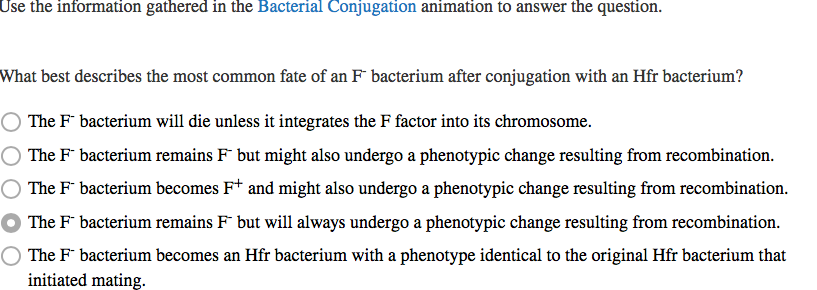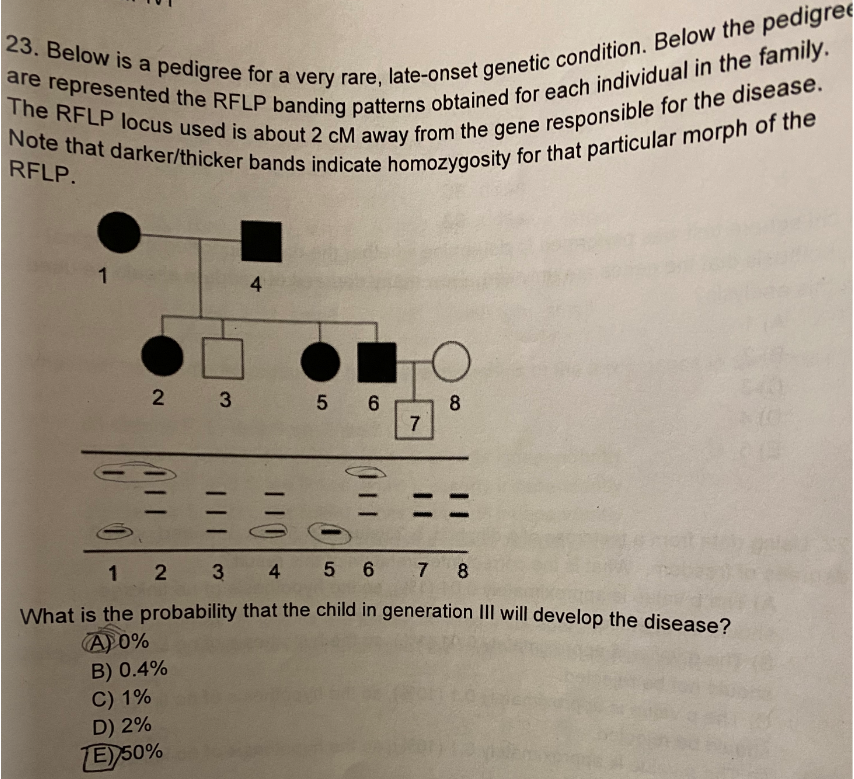An F+ Microbial Strain Would Best Be Described as:
Conjugation between F and F- cell. The NMSC will accept deposits of microbial isolates strains following a screening and approval process that is further described below.

Solved Ng E G Parents And Offspring Always Have The Same Chegg Com
Pages 19 Ratings 100 19 19 out of.

. Incapable of conjugation due to inhibitory genes on the F plasmid. A any bacterium that readily takes up naked DNA through its membrane. A bacterium containing a chromosomally integrated plasmid conferring mating competency.
The best place to double-check strain IDs is The Bacterial Diversity Metadatabase BacDive which lists the original strain designation alongside the IDs used by different collections. Group of answer choices the wild-type leu gene has been transferred from A to B the wild-type leu. Hfr StrSxyz and F- StrRx-y-z-.
A F b F. C F super strains. Considerations when Selecting a Supplier.
B F-cell becomes F. Specialized transduction is mediated by. F bacterial strain A met his- argt lys- is mixed with F- bacterial strain B met- his arg- lys grown in complete media then plated on minimal media supplemented with methionine and arginine.
An F microbial strain would best be described as. What are F and F bacteria. If the F factor is attached to the bacterial genome the donor is called as.
An F microbial strain would best be described as A any bacterium that readily. B incapable of conjugation due to inhibitory genes on the F plasmid. An f microbial strain would best be described as a.
F Bacterial strains that contains Fertility factor plasmid F plasmid. A bacterium with a plasmid that confers mating competency or fertility. Same without ant change.
A bacterial strain with specific auxotrophic characteristics. Any bacterium that readily takes up naked DNA through its membrane. School Texas Tech University.
A bacterial strain that carries a phage with membrane fusion competency. Generally the largest repositories of microbial strains are national culture collections. These bacteria are able to transfer their F plasmid into bacteria which lack F plasmids.
Bacterial strains which have F plasmids are characterized as F strains. An F microbial strain would best be described as. The bacterium is F and is the donor.
A bacterium containing a chromosomally integrated plasmid. A Two F- cells. To submit strains to the NMSC please complete the Strain Deposit Form.
An Hfr microbial strain would best be described as. An Hfr microbial strain would best be described as. Conjugative plasmids initiate gene transfer by altering the cell surface to allow contact between the plasmid-containing donor cell F or male and a plasmid lacking recipients F- or female Sex pilus originates from the donor and establishes conjugative bridge temporary cytoplasmic bridge.
A bacterial strain with specific auxotrophic characteristics. A bacterium carrying an Hfr. A any bacterium that readily takes up naked DNA through its membrane.
F F plasmids are derivatives of the. An interrupted conjugation experiment is conducted using the following strains. An F microbial strain would be best be described as.
NIST established the NIST Microbial Strain Collection NMSC to advance microbial research and support standards development. C a bacterial strain with specific auxotrophic characteristics. Any bacterium that readily takes up naked DNA through its membrane.
F plasmid is a conjugative plasmid which contains genetic information that codes for pilin used to make sex pilus necessary for conjugation. Conjugation between F and F- cell results in. F plasmids contain a fertility factor or F factor which is essential for bacterial conjugation.
The colonies that grow on the plate indicate that _____. Any bacterium that readily takes up naked DNA through its membrane b. Bacteria grows on the plate which indicates that none of these conclusions are supported the wild-type met and arg genes have been transferred from A to B.
Course Title BIOL 3416. Mechanism of plasmid mobilization by conjugation. A bacterial strain with specific auxotrophic characteristics.
An F microbial strain would best be described as. A bacterium that lacks the histidine frequenase gene. Hfr and F strains are correctly described by all of the following EXCEPT F strain has F factor integrated in the bacterial genome Hfr strain has F factor integrated in the bacterial genome F strain has low recombination frequency Hfr strain does not convert an F- strain to an F strain 02 pts Question 9 Which of the following statements is NOT true about.
B incapable of conjugation due to inhibitory genes on the F plasmid. F bacterial strain A leu ser- thr lys- is mixed with F- bacterial strain B leu- ser thr- lys grown in complete media then plated on minimal media supplemented with leucine. A bacterium that lacks the histidine frequenase gene.

Solved Question 1 F Strain And Hfr Strain Bacteria Are Chegg Com

Solved Use The Information Gathered In The Bacterial Chegg Com

Solved Ng E G Parents And Offspring Always Have The Same Chegg Com

What Is The Difference Between An F And Hfr Strain Which Type Of Strain Do You Expect To Transfer Many Bacterial Genes To Recipient Cells Study Com
No comments for "An F+ Microbial Strain Would Best Be Described as:"
Post a Comment